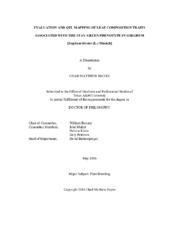| dc.description.abstract | Stay-green is an important agronomic trait in grain sorghum that produces higher, and more stable grain yields under drought stress post-anthesis. Historically, stay-green has been evaluated and selected for visually in the field with a rating system known as leaf and plant death rating (LPD). LPD ratings are notoriously difficult to replicate, and require many environments for evaluation, primarily due to uncontrollable rainfall events, but also field variability. There is a need for a quick and reliable screening method to identify stay-green sorghums. The objectives of this research are to evaluate the efficacy of two lab-based bioassays for identification of stay-green within a RIL population derived from BTx642/Tx7000 and a set of diverse breeding lines. Additionally, leaf sugar compounds and there role in reducing post-flowering drought stress is explored through genetic analysis.
Quantum efficiency (Fv/Fm) measurements made on leaf tissue from each RIL were evaluated for correlations with leaf and plant death (LPD) ratings. Results indicate that statistical differences between stay-green classes and non stay-green classes exist with this bioassay. The two RIL parents in this study, BTx642 and RTx7000, had differential responses in both LPD rating and quantum efficiency. The assay was much less robust in separating the RILs, possibly due to intermediate LPD ratings observed in most RILs and also from environmental effects.
Leaf dhurrin at anthesis was quantified for each RIL in this study and was found to be highly correlated with LPD. Environment was the largest source of variation, much greater than genotype or replication. The dhurrin assay was recommended for QTL mapping based on a strong correlation with LPD, and a low CV (%) observed in the study.
A leaf dhurrin QTL (Dhu1) was discovered in this study on SBI01 using the BTx642/Tx7000 RIL population. Dhu1 was highly heritable and explained a large percentage of the variation of leaf dhurrin in the population. Dhu1 is aligned with genes involved in dhurrin biosynthesis on SBI01. Dhu1 is also aligned with a previously un-identified stay-green QTL (Stg5) on SBI01, consistent with previous studies identifying an association between leaf dhurrin and stay-green.
A diverse set of ten breeding lines were also evaluated in four locations in 2014 for leaf dhurrin, leaf sugars and stay-green (LPD). Dhurrin was highly correlated with LPD rating from 2014 and all documented stay-green lines contained 2-3x higher dhurrin levels than senescent sorghums. Repeatability for dhurrin and LPD was very high and GxE effects were relatively small, indicating that selection for high dhurrin is a good predictor for stay-green and that high dhurrin lines rank similarly when compared to low dhurrin lines, regardless of the environment. | en |


